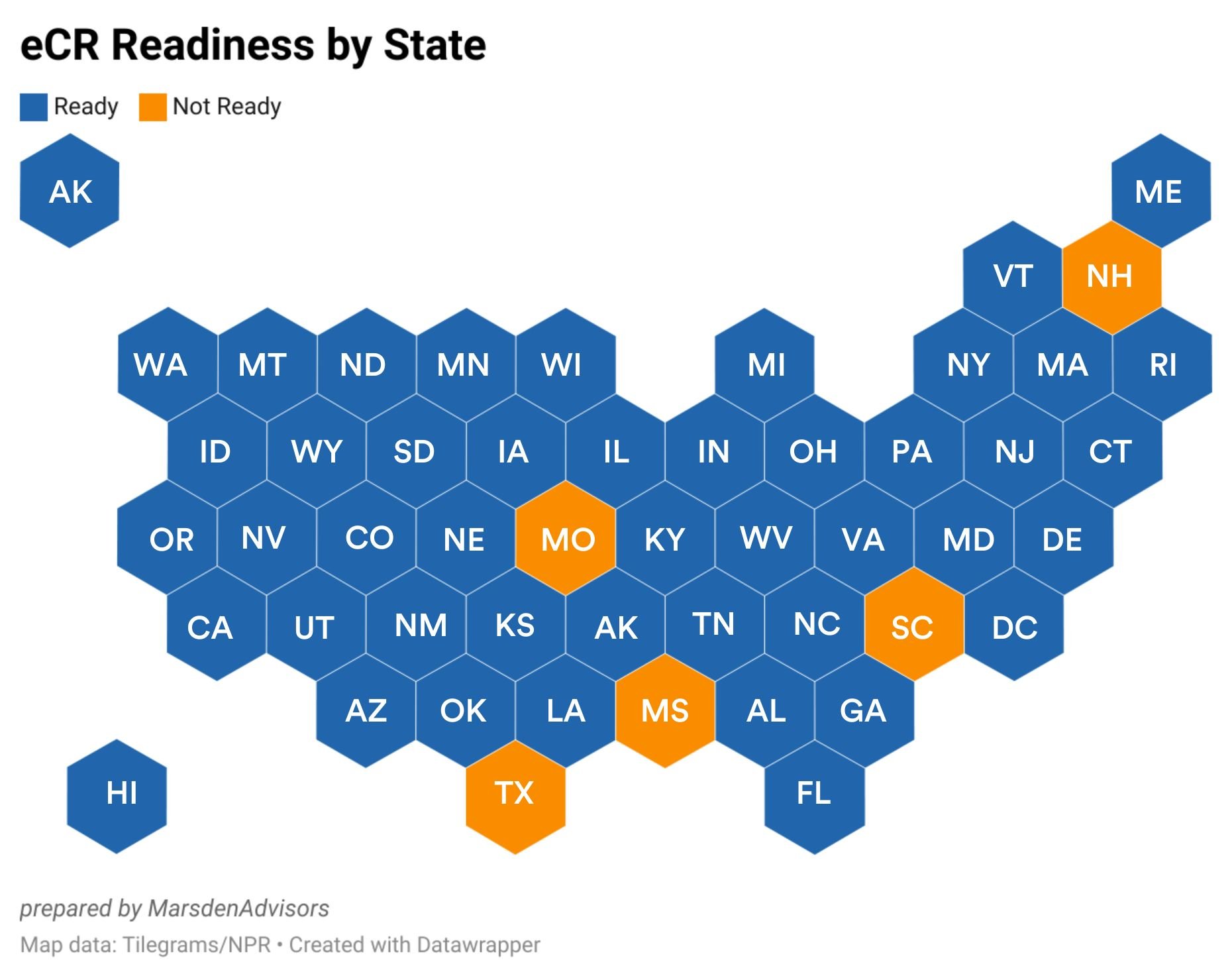While Electronic Case Reporting (eCR) has been required under the MIPS Promoting Interoperability category for almost a year now, many states were not prepared to receive these reports. As we head into the second year of required eCR, let's review what states are, and aren't, ready to receive eCR, as well as what to do if your state has not declared readiness.
What Does This Mean For Your Practice?
While your practice should be prepared report on this measure (unless citing an exclusion) for the 2022 performance year, the situation is still evolving, with more declaring readiness every few months. This means that while you may have been able to claim an exclusion in the 2022 performance year, you might need to now start the process of actively engaging with eCR if your state has since declared readiness. So, this blog can keep you up-to-date on those changes, as well as let you know what to do if your state is not ready yet.
What is eCR?
eCR allows automated, real-time exchange of relevant clinical data between EHRs and public health agencies (PHAs) and streamlines the case reporting process. However, up until the COVID-19 pandemic, PHAs often had not enabled eCR functionality, and EHRs, thus, had little incentive to develop the functionality.
To provide this incentive and to facilitate less burdensome, more complete, and more accurate public health reporting in the future, the Centers for Medicare and Medicaid Services (CMS) decided to require electronic case reporting beginning with MIPS performance year 2022.
How does eCR work?
eCR has five steps:
- Patient is diagnosed with a reportable condition (like COVID-19).
- Their provider enters this information into their EHR.
- Data in the EHR automatically triggers a case report that is validated and then sent to all appropriate public health agencies.
- The public health agency receives the report in real-time and responds to the provider about the reportability of the case.
- State health department reaches out to the patient regarding contact tracing or other public health actions.
For these steps to occur, the state health department has to be prepared to receive these automatically triggered case reports, but not every state has declared readiness to do so.
What States are Ready to Receive eCR?

| State | Declared Readiness? | State | Declared Readiness? |
| Alabama | Yes | Montana | Yes |
| Alaska | Yes | Nebraska | Yes |
| Arizona | Yes | Nevada | Yes |
| Arkansas | Yes | New Hampshire | No |
| California | Yes | New Jersey | Yes |
| Colorado | Yes | New Mexico | Yes |
| Connecticut | Yes | New York | Yes |
| Delaware | Yes | North Carolina | Yes |
| District of Columbia | Yes | North Dakota | Yes |
| Florida | Yes | Ohio | Yes |
| Georgia | Yes | Oklahoma | Yes |
| Hawaii | Yes | Oregon | Yes |
| Idaho | Yes | Pennsylvania | Yes |
| Illinois | Yes | Rhode Island | Yes |
| Indiana | Yes | South Carolina | No |
| Iowa | Yes | South Dakota | Yes |
| Kansas | Yes | Tennessee | Yes |
| Kentucky | Yes | Texas | No |
| Louisiana | Yes | Utah | Yes |
| Maine | Yes | Vermont | Yes |
| Maryland | Yes | Virginia | Yes |
| Massachusetts | Yes | Washington | Yes |
| Michigan | Yes | West Virginia | Yes |
| Minnesota | Yes | Wisconsin | Yes* |
| Mississippi | No | Wyoming | Yes |
| Missouri | No |
*Wisconsin is able to receive eCR on COVID-19 only. This still meets the requirement for the eCR measure in MIPS.
What If My State Is Ready to Receive eCR?
If your state is ready to receive eCR, it is important that you communicate directly with the relevant public health authority to get the process started for you to be able to participate. This measure requires active engagement to receive full points for your Promoting Interoperability score.
What If My State Isn't Ready to Receive eCR?
While this requirement has been in place for almost a year now, some states are still working on becoming capable of receiving eCR. CMS has allowed for three exclusions to this measure:
- Clinician does not treat or diagnose any reportable diseases for which data is collected by their jurisdiction's reportable disease system during the performance period. OR
- Operates in a jurisdiction for which no PHA is capable of receiving electronic case reporting data in the specific standards required to meet the CEHRT definition at the start of the performance period. OR
- Operates in a jurisdiction where no PHA has declared readiness to receive electronic case reporting data as of 6 months prior to the start of the performance period.
So, in the case that your state is not yet ready to receive eCR, you should prepare to claim exclusion 3 for this measure.
We will keep this table and map updated as more states declare their readiness.
Next Steps
- Share this information with your practice colleagues.
- Subscribe to our newsletter to get alerts on this and other important issues. You can subscribe using the field in our website footer below.
- Contact your Client Success Manager if you have any questions.
- If you’re not a MarsdenAdvisors client and you want hands-on, personalized assistance, contact us and we will have your back.
If you have any questions on this, let us know!

